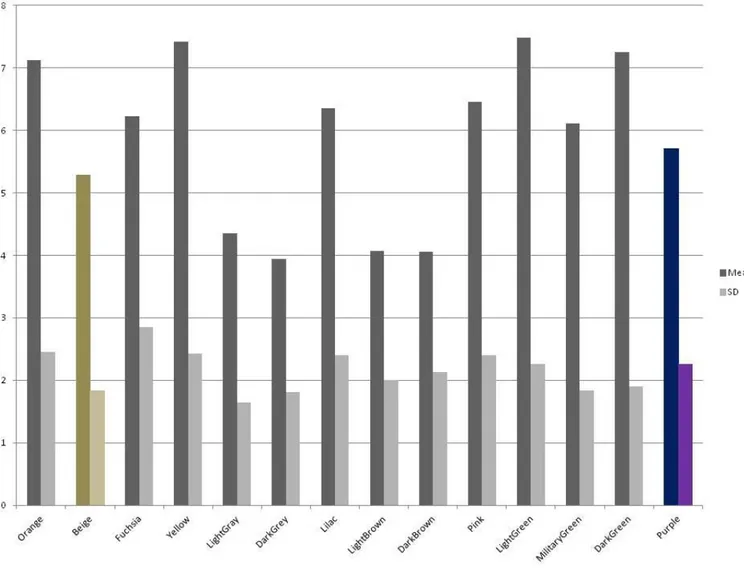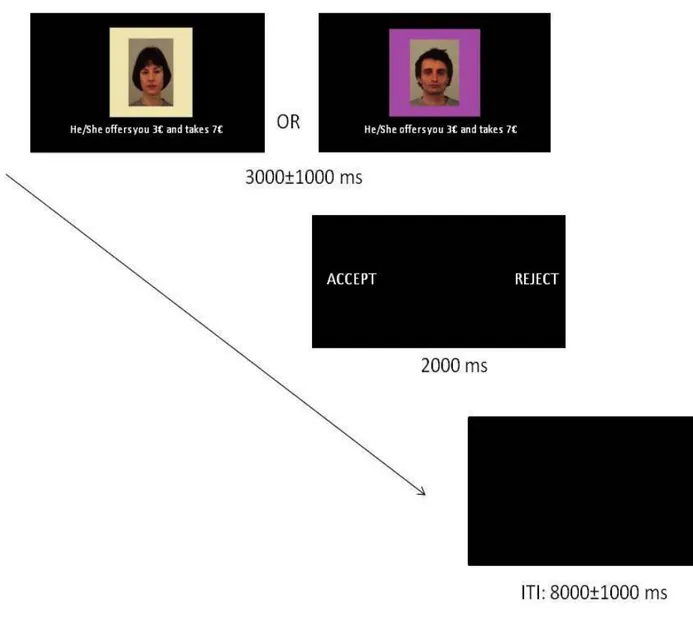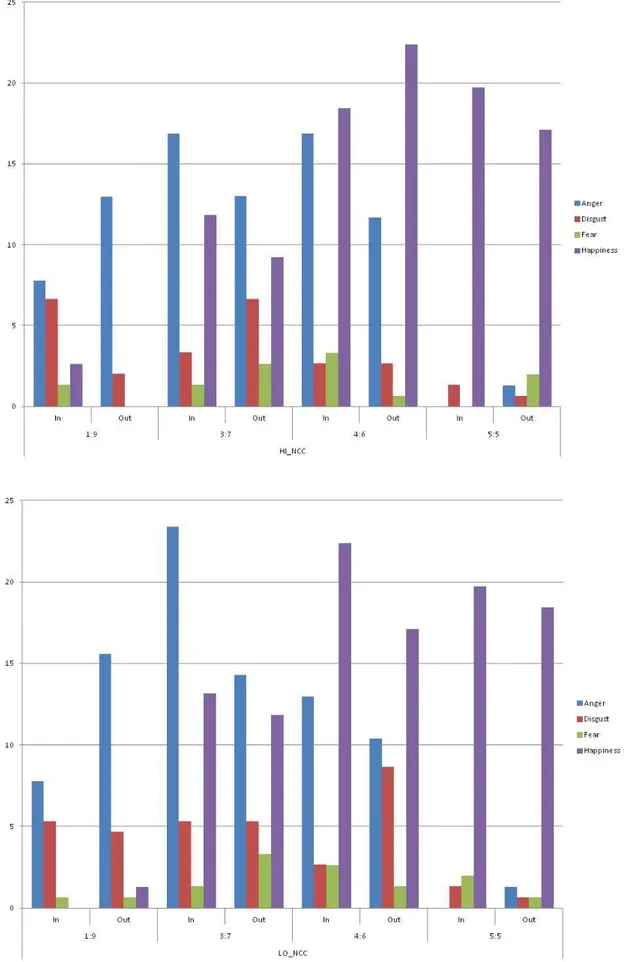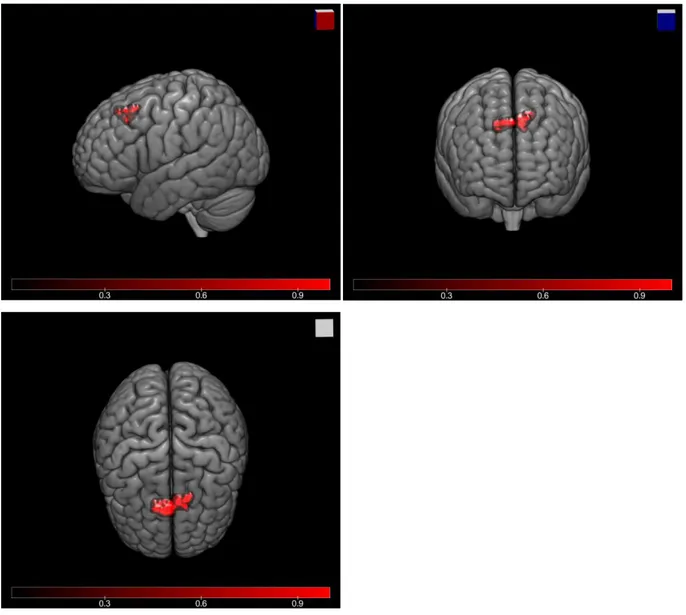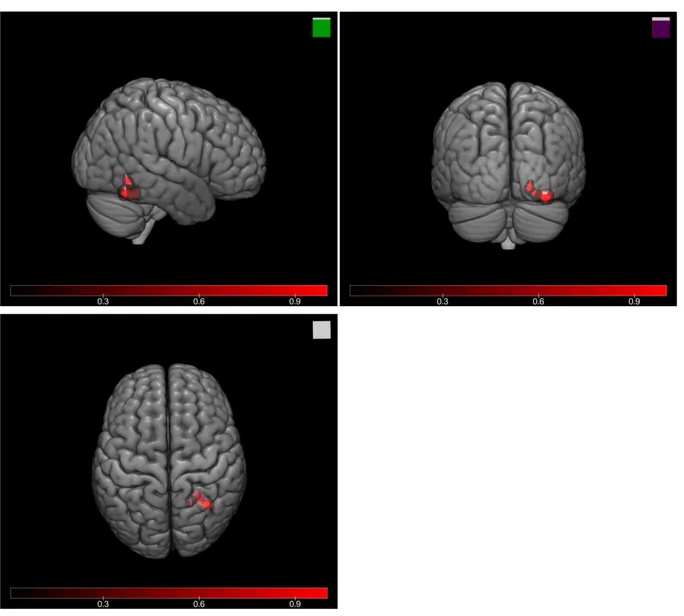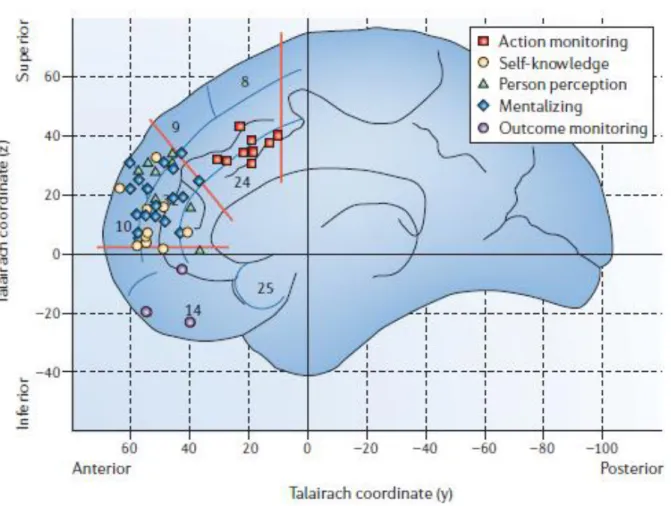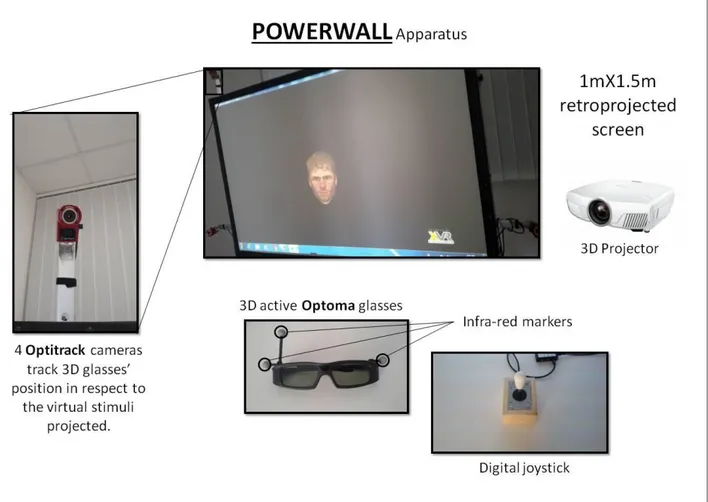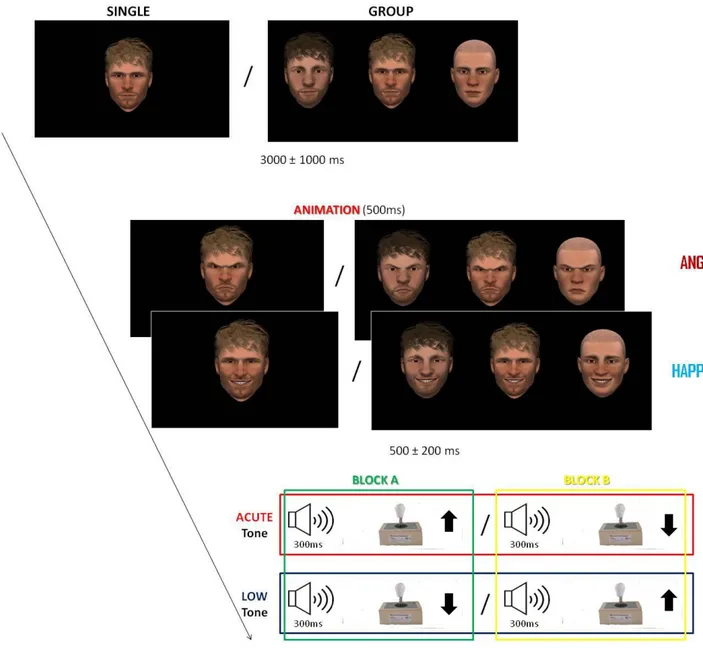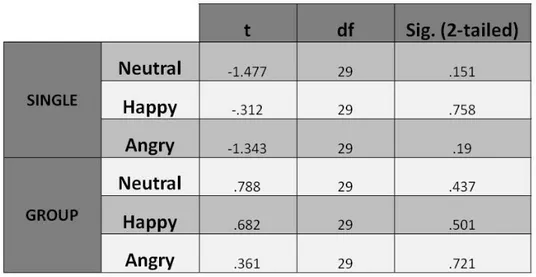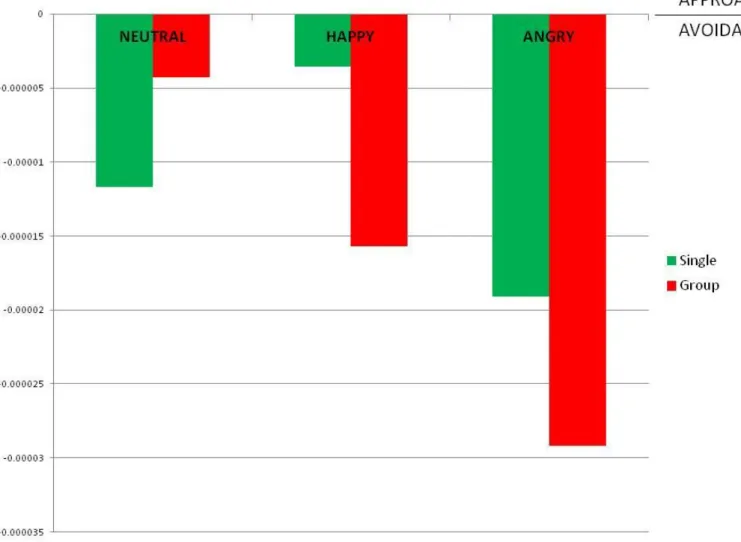University of Rome “La Sapienza”
Department of Psychology
International Doctor of Philosophy course in
Cognitive Social and Affective Neuroscience
cycle XXX
THE ROLE OF NEED FOR COGNITIVE CLOSURE AND EMOTIONS
IN SHAPING THE HUMAN SOCIAL INTERACTIONS AND
DRIVING THE INTERGROUP DECISION BEHAVIOUR
FINAL DISSERTATION
Candidate Supervisor
Dott. Adriano Acciarino Prof. Lucia Mannetti
Reviewers Official Referee
Prof. Beatrice De Gelder Dr. Rita Formisano
Prof. Małgorzata Kossowska Prof. Fabio Lucidi Prof. Camillo Regalia Dr. Paolo Riva
Table of contents
____________________________________________________
Table of contents ... 3 List of Figures. ... 5 List of Tables ... 6 List of Abbreviations ... 7 List of Publications ... 8 1. Introduction 1.1 Need for Cognitive Closure and Epistemic Motivation ... ..91.2 Emotions’ role in Cognition and Decision Making...15
1.3 Intergroup Dynamics, NCC and Emotions ... 18
2. The Need for Cognitive Closure and Negative Emotions Toward Ingroup/Outgroup Individuals in Bargaining Behaviour 2.1 Introduction ... 19
2.2 Study1 ... 20
2.2.1 Study1.a: Perceived Closeness and Similarity of Different Nationalities for Italian Participants Procedure... 20
Results ... 21
Discussion...22
2.2.2 Study 1.b: Disgust, Anger and Fear Toward Other Nationalities Procedure... 23
Results ... 24
Discussion...27
2.2.3 Study 1.c: The Bargaining Behaviour Towards Similar and Dissimilar Individuals Procedure... 27
Results ... 29
Discussion...32
2.2.4 General Discussion...32
2.3 Study2: The Role of Need for Cognitive Closure in Bargaining Behaviour: an Ingroup/Outgroup fMRI Study...34
Procedure...34
Preprocessing and fMRI Data Analysis...37
Behavioural Results... ...38
fMRI Results... ...41
Discussion...46
2.4 Conclusions...48
3. General Discussion……….63
APPENDIX A: The Arithmetic of Emotional Contagion 1 Introduction 36 2 Virtual Reality for Studying Social and Affective Phenomena ... 37
3 Study3: Influence of Emotional Contagion on Approach/Avoidance Behaviour Procedures ... 52
Results.. ... 55
Discussion ... 61
Bibliography... 65
List of Figures
____________________________________________________
Figure 2.2.1: Levels of perceived Closeness and Similarity for each nationality...23
Figure 2.2.2: Different trends between Hi-NCC and Lo-NCC in emotions...28-29 Figure 2.2.3: Example of an UG stimulus ... 31
Figure 2.2.4: General rejection trend ... 32
Figure 2.2.5: Differences in rejection rate between Hi-NCC and Lo-NCC ... 33
Figure 2.3.1: Means and SD for positive/negative emotions and colors ... 38
Figure 2.3.2: Example of experimental procedure ... 39
Figure 2.3.3: Percentages of emotions’ rating for Hi-NCC and Lo-NCC... 42
Figure 2.3.4: Rejection rate for Hi-NCC and Lo-NCC ... 43
Figure 2.3.5: 3D Render Superior Frontal Gyrus ... 45
Figure 2.3.6: 3D Render Fusiform Gyrus ... 46
Figure 2.3.7: Functional Map (Amodio & Firth, 2006) ... 47
Figure A.1: Experimental setup ... 72
Figure A.2: Experimental procedure ... 74
Figure A.3: Approach/Avoidance tendency ... 77
Figure A.4: Ratings of Intensity, Realism, Trustworthiness and Attractiveness…...80
List of Tables
____________________________________________________
Table 2.2.1: Means and SD of Similarity and Closeness ... 24
Table 2.2.2: Percentage of Disgust, Anger and Fear ... 27
Table A.1: t-Test for Approach/Avoidance ... 76
List of Abbreviations
____________________________________________________
ACC Anterior Cingulate CortexAI Anterior Insula Av1 Avatar #1 Av2 Avatar #2 Av3 Avatar #3 EC Empathic Concern FG Fusiform Gyrus
fMRI Functional Magnetic Resonance Imaging
IRI Interpersonal Reactivity Index
prMFC posterior rostral Medial Frontal Cortex NCC Need for Cognitive Closure
PFC PreFrontal Cortex
SPM Statistic Parametric Mapping
UG Ultimatum Game VE Virtual Environment VR Virtual Reality
List of Publications
____________________________________________________
Chiesa P.A., Liuzza M.T., Acciarino A., Aglioti S.M. (2015). Subliminal Perception of others' physical pain and pleasure. Experimental Brain Research, 1-10.
Doi: 10.1007/s00221-015-4307-8
Fiori, F., Candidi, M., Acciarino, A., David, N., & Aglioti, S. M. (2015). The right temporo parietal junction plays a causal role in maintaining the internal representation of verticality. Journal of Neurophysiology, jn-00289.
1. Introduction
____________________________________________________
1.1 -
Need for Cognitive Closure as Epistemic Motivation
The Need for Cognitive Closure (NCC), a psychological motivational construct between the cognitive and the social domain, has been originally introduced by Arie Kruglanski (1980) in a scientific article on epistemics. NCC theory has been applied to a variety of phenomena in the field of social cognition (see Kruglanski&Webster, 1996) and of cognitively driven group dynamics (see Kruglanski, Pierro, Mannetti, & De Grada, 2006). NCC is defined as the desire for “an answer on a given topic, any answer . . . compared to confusion and ambiguity” (Kruglanski, 1990, p. 337). It constitutes a core motivational construct of Kruglanski’s theoretical framework of lay epistemics, a theory about the process of knowledge formation and consolidation (e.g., Kruglanski, 1980, 1989; Kruglanski, Dechesne, Orehek, & Pierro, 2009; Kruglanski, Orehek, Dechesne, & Pierro, 2010). NCC’s magnitude is determined by the perceived costs and benefits of being “closed”. A known trigger for high situational NCC is time pressure that people daily experience (e.g., Bukowski, von Hecker, & Kossowska, 2013; Kruglanski & Freund, 1983, Richter & Kruglanski, 1998; Roets & Van Hiel, 2011a). The attainment of closure cut off the necessity for further information processing when it is difficult and/or aversive. For example, if a task is boring or not interesting (e.g., Webster, 1993a), if performance is impeded by external stressors such as environmental noise (e.g., Kruglanski, Webster, & Klem, 1993), or if processing is tiresome (e.g., Webster, Richter, & Kruglanski, 1996), people may also experience an increased desire to reach closure (see Kruglanski, 2004; Kruglanski & Webster, 1996 for an overview). Kruglanski and Webster (1996) portrayed the motivation toward cognitive closure as lying on a continuum between a high need to attain closure and a high need to avoid it. For instance, in circumstances where information processing is experienced as intrinsically rewarding or of high interest (e.g., Webster, 1993b), people are more motivated to postpone or avoid closure. In addition to transient states induced by situational determinants, the NCC also represents a dimension of stable individual temperamental differences (Webster & Kruglanski, 1994). Individuals with high levels of dispositional NCC are characterized by a preference for order and predictability, afforded by secure knowledge that is stable across circumstances and unchallenged by exceptions. High NCC individuals also experience an urgent desire to reach firm decisions, reflected in their need for decisiveness, and their discomfort feeling toward ambiguity,
experiencing situations lacking closure as aversive. Finally, they are closed-minded, resistant to information inconsistent with their firm opinions, and reluctant to have their knowledge challenged (Roets, Kruglanski, Kossowska et al., 2015). To measure “trait” NCC, Webster and Kruglanski (1994) developed the NCC scale, which was later revised by Roets and Van Hiel (2007), and cross-culturally adapted (Mannetti, Pierro, Kruglanski et al., 2002). Both the original and the revised scale include the five initially proposed expressions of NCC: 1- preference for order, 2- preference for predictability, 3- decisiveness, 4- aversion for ambiguity, and 5- closed-mindedness. Several studies have shown consistently that the effects obtained with the individual difference measure converge with those obtained with the situational manipulations of NCC (e.g., see Roets, Van Hiel, Cornelis, & Soetens, 2008; Webster & Kruglanski, 1994). Such convergence supports the claim that motivation for closure is a psychological mindset with a variety of determinants including situational conditions and chronic personality tendencies, with temperamental and genetic origins, as well as stemming from cultural norms and habits (see Kruglanski & Webster, 1996). The construct of NCC fits within the long history of psychological research and theorizing on individuals’ tendency toward closed- versus open-mindedness and shares features with related concepts such as intolerance of ambiguity (Eysenck, 1954; Frenkel-Brunswik, 1949), uncertainty orientation (Sorrentino & Short, 1986), openness to experience (McCrae & Costa, 1985), and need for cognition (Cacioppo & Petty, 1982). NCC is distinct from these other notions due to its explicitly motivational foundations, rather than cognitive or personality ones (see Kruglanski, 2004; Kruglanski & Webster, 1996). Empirically, NCC yields modest relations with these variables, and yields unique relations with third variables (see e.g., Cornelis & Van Hiel, 2006; Kruglanski & Webster, 1996; Onraet, Van Hiel, Roets, & Cornelis, 2011; Roets & Van Hiel, 2011b).
When the level of situational or trait NCC is high, the absence of closure represents a stressful divergence from a desired state. Roets and Van Hiel (2008) found that, in a decision-making context, individuals high (but not low) in NCC showed higher levels of distress both in terms of increased systolic blood pressure and increased heart rate during the task, and in terms of increased retrospectively reported distress. In a follow-up study (ibidem) where closure was not readily attainable, high (but not low) NCC individuals showed a progressive increase of galvanic skin response (GSR), which is considered a measure of the general arousal, when not conclusive solutions were obtained. Also, for high NCC individuals, this stressful absence of closure tends to promote activities aimed at the attainment of closure, and influence the individuals’ choices and preferences (Kruglanski & Webster, 1996; p. 264); these affect
information processing, knowledge formation, and decision-making. Theoretically, high NCC was said to prompt two general tendencies, known as “urgency” and “permanence” (Kruglanski & Webster, 1996). Urgency denotes an inclination to seize quickly on information that seems to bring about closure. Individuals with high levels of NCC may often jump to judgments based on partial or inconclusive evidences. Permanence, in contrast, denotes the inclination to maintain closure by holding onto or freezing on the acquired knowledge. This
freezing process reinforces the consolidation of such knowledge, and protects it against the
threat of ambiguous information. Both “gate-keeping” tendencies serve to escape the aversive lack of closure, by terminating this state quickly (urgency), and by keeping it from recurring (permanence). One of the most straightforward consequences of the inclination to seize and freeze elicited by NCC pertains to the extent to which people categorize information and develop hypotheses. Indeed, the desire to reach closure quickly, and to subsequently maintain it, should lead people to take in consideration less information than necessary when making judgments. Mayseless and Kruglanski (1987) asked participants to identify a series of briefly presented, individual digits. Participants were allowed to request repeated presentations of the digit to be identified. The extent of informational search was highest in the need to avoid closure condition (induced by manipulation of the fear of invalidity), intermediate in the control condition, and lowest in the NCC condition (induced by instructions stressing the formation of unambiguous opinions, rather than the importance of being correct). This effect later was corroborated by Roets and collegues (2008) across different NCC manipulations (i.e., noise, time pressure, and fear of invalidity), and was cross-validated with the dispositional measure of NCC (Roets et al., 2008; Roets & Van Hiel, 2006). The moment when a belief “crystallizes” and turns from conjecture to a subjectively firm and true “fact” (Kruglanski & Webster, 1996) represents the demarcation point that separates seizing from freezing tendencies. A joint operation of both seizing and freezing tendencies may underlie the NCC effects. Indeed, most decisions involve both pre- and post-crystallization stages, and seizing and freezing processes are strongly aligned because the motivation to quickly reach the closure or ending the aversive lack of it, and the motivation to remain in this state or preventing the aversive lack of closure from recurring, are strongly interlaced. NCC differences in information sampling and categorization are most prominent under conditions where epistemic motivation is most relevant for behaviour (see Wright & Kirby, 2001). In another study, (Mayseless & Kruglanski, 1987) where presented to participants enlarged pictures of common objects, taken at unusual angles to mask their specific structure, and asked participants to list all hypotheses about the identity of the object. The number of generated hypotheses was the smallest in the high NCC
condition, intermediate in the control condition, and largest in the need to avoid closure condition. In addition to these effects, the NCC, through the instigation of seizing and freezing tendencies, has effects on a number of classic phenomena in social and cognitive psychology (Kruglanski & Webster, 1996). It was shown that high NCC induced through time pressure inflates primacy effects (Kruglanski & Freund, 1983; Freund, Kruglanski, & Shpitzajzen, 1985; Heaton & Kruglanski, 1991; Webster & Kruglanski, 1994; Webster et al., 1996), increases the tendency to base judgments on stereotypes (Dijksterhuis, van Knippenberg, Kruglanski, & Schaper, 1996; Jamieson & Zanna, 1989), and heightens assimilation of numerical estimates to anchor values (Kruglanski & Freund, 1983). It was also demonstrated that NCC increases attributional biases (Webster, 1993a) and the effects of priming (Ford & Kruglanski, 1995). Each of these effects reflects an urgency driven reliance on accessible early information, and a permanence driven disregard of later information. Stereotypes and other early salient cues provide initial bases for judgments. Moreover, because repeated exposure is assumed to increase the perceived plausibility of an initial hunch, the strong reliance on such initial “information” under high NCC can also strengthen exposure effects, as demonstrated in a series of studies (Kruglanski, Freund, & Bar-Tal, 1996). Seizing and freezing also translate into interpersonal phenomena, such as negotiation, where high NCC individuals are shown to be more influenced by focal points when setting limits and making concessions, and to rely strongly on stereotypic and preliminary perceptions of their opponents (DeDreu, Koole, & Oldersma, 1999). In addition, different studies examined NCC effects in intra- and inter-group contexts. Kruglanski and collegues (2006) integrated these social NCC effects under the hypothesis of group-centrism. Specifically, it has been revealed that individuals with high NCC levels tend to prefer an autocratic group decision structure, in which consensus is stable and closure affordable, deriving from the disproportionate influence of the group’s leaders (De Grada, Kruglanski, Mannetti, & Pierro, 1999; Pierro, Mannetti, De Grada, Livi, & Kruglanski, 2003). The group-centric tendency manifest under high NCC also finds expression in pressure toward opinion uniformity, including a firm rejection of opinion deviates (Kruglanski & Webster, 1991), a distaste for diversity of membership, as well as aversion toward Outgroups whose actions or opinions may threaten the Ingroup’s point of view (Pierro et al., 2003; Shah, Kruglanski, & Thompson, 1998). In line with this, Livi and collegues (2015) found that groups composed of individuals high (vs. low) on NCC exhibited greater stability of group norms across different generations of group members. Because groups provide shared knowledge that is easily accessible, high NCC individuals are wishful to embrace the attendant epistemic security and to protect it from outside influences as well as from inside threats. Group-centrism
can be considered the result of reliance on easily accessible, shared Ingroup knowledge as well as derogation of new Outgroup information. Differential effects of seizing and freezing can also play an important role in the acculturation processes of immigrants. In particular, Kosic, Kruglanski, Pierro, and Mannetti (2004) examined the impact of NCC on the acculturation of Croatian and Polish immigrants in Italy. Consistently, acculturation patterns were interactively determined by immigrants’ NCC and the reference group in which they found themselves upon their arrival. Specifically, if the immigrants arrived in the host country together with other co-ethnics, higher levels of NCC were linked with a stronger tendency to adhere to the culture of origin (freezing) and thus decreased their tendency to assimilate to the host culture. By contrast, if on arrival they found themselves without other co-ethnics, higher levels of NCC augmented their tendency to embrace and adapt to the host culture and consequently reduced their adherence to the culture of origin. These findings indicate that, with the aim to reduce the considerable uncertainty associated with arrival in a new country, high NCC immigrants may turn to whichever cultural reference framework is most able to provide closure; in the group of co-ethnics, freezing on the culture of origin provides most immediate closure, whereas in the absence of the co-ethnic reference group, assimilation to the host country (seizing) provides
closure best.
Other behavioural studies have demonstrated that high NCC is related to an increased focus on a specific part of the cognitive field, suggesting that it affords cognitive selectivity and the ability to shut out irrelevant noise (Kossowska, 2007a, 2007b; Kruglanski & Webster, 1996; Pica et al., 2013, 2014). It has also been revealed that NCC reduces the incidence of uncertainty and conflictuality by privileging answers that accommodate precedent experience, representing a goal pursuit that turns attention away from discrepancy. These psychological differences between high and low NCC individuals may map onto two cognitive processes: attentional control (Lackner, Santesso, Dwyan, Wade & Segalowitz, 2013) and conflict monitoring (Botvinick, Braver, Barch, Carter, & Cohen, 2001). Kossowska and collegues (2015) investigated whether NCC is related to selective attention, as reflected in Event-Related Potentials (ERPs) during a classical Stroop task (1935) as well as a Visual Distractor Task (VDT). In this latter task, a small letter against an emotional picture was presented in a random location on the computer screen. The required response was determined by a cue shown just before the picture. Both of the tasks involved competition between target and irrelevant features, and require participants to answer to one dimension of a stimulus rather than another stronger and conflicting one. Therefore, these tasks require feature selection and allow to study early allocation of attention to the selected feature of the stimuli. The selective attentive control
is usually indexed by N1 component of the ERPs (Herrmann & Knight, 2001), a negative visual evoked component with peak at 150-200ms, in the direction of greater deviations in N1 for increased focus on attended stimuli and increased suppression of attentional response to unattended ones (Singhal, Doerfling, & Fowler, 2002). This study revealed that individuals with higher NCC levels allocate more attention to the selected stimuli of features, and this behaviour is related to higher N1 amplitude both in Stroop (bilaterally) and VDT (right-sided). In addition, Kossowska, Czarnek, Wronka, Wyczesany, and Bukowski (2014) have shown that high (vs. low) NCC is related to conflict monitoring process, defined as a general mechanism for detecting when one’s habitual response tendency is mismatched with responses required by the situation (Yeung, Botvinick, & Cohen, 2004). Specifically, low NCC level was associated with higher conflict-related neural activity when response inhibition was required. The ElectroEncephaloGraphic (EEG) activity was recorded as participants completed a Stroop task. Conflict-related Anterior Cingulate Cortex (ACC) activity was indexed by two ERP components: error-related negativity (ERN), a negative evoked component with peak at 80-150ms, and the N2 component, a negative wave with peak at 200-350ms. Low NCC level was strongly and negatively correlated with ERN amplitudes, as well as with N2 amplitudes when participants performed incongruent vs congruent trials. To summarize, high NCC was related with higher neural activity when selection processes occurred (increased N1 component), while also predicting lower conflict-related activity (decreased ERN and N2 components). These results suggest that a speeded neural response to a distracting stimulus in high NCC individuals, disengaging attention from task-irrelevant information, confers some advantage in acting as a barrier against anxiogenous uncertainty and minimizing the experience of error (Hajcak, 2012; Weinberg, Riesel, & Hajcak, 2012). On the other hand, the greater selective focus on the target exhibited by high NCC individuals may exact a toll on flexibility due to freezing. In a study by Viola and collegues (2014), it has been used the Flanker Task (Eriksen & Eriksen, 1974) to investigate this hypothesis. Participants were instructed to answer to a centrally presented target but they had to disregard surrounding flanker stimuli, congruent or incongruent with the target one. It was found that high NCC individuals exhibited lesser cognitive flexibility, operationally defined as a reduced response time to incongruent vs congruent relations between target and flanker stimuli if the preceding trial was incongruous (vs congruous). Of particular interest, these differences were mediated by decreased cortico-cortical connectivity between the ACC and the dorsolateral prefrontal cortex (DLPFC) as assessed by a generalized PsychoPhysiological Interactions (gPPI) analysis. Such reduction of the functional connection between the ACC and DLPFC regions has previously been related to
impairment of mechanisms for adaptation to conflict (Botvinick, Nystrom, Fissell, Carter, & Cohen, 1999; Kerns et al., 2004).
1.2 -
Emotions’ role in Cognition and Decision Making
As a large body of scientific research documents, moods and emotions can influence cognitive processes (see Clore, Schwarz, & Conway, 1994; Forgas, 1995; Schwarz & Clore, 1996). Emotions influence attention (Vuilleumier, 2005), decision-making (Bechara, Damasio et al., 1999), memory (Phelps, 2006), physiological responses (Cacioppo et al., 2000; Levenson, 2003), and social interactions (Keltner & Kring, 1998). However, even as they shape a lot of intrapersonal and interpersonal processes, emotions are subject to modification. The successful regulation of emotion is related to important psychological, social, and physical outcomes (Gross, 2002; Abelson et al., 2005; Gross, 2007). Conversely, difficulties with emotion regulation have been considered as a mechanism underlying mood and anxiety disorders (Campbell-Sills & Barlow, 2007). Understanding the impact of different types of emotion regulation on experience, behaviour, and neural dynamics, may inform clinical practice and research. Gross’ model of emotion regulation (1998) distinguishes between antecedent-focused strategies, which modulate early emotional tendencies, before they give rise to full responses, and response-focused strategies, which modulate the emotional responses themselves once they
have arisen.
Individuals are more likely to recall information from memory that is congruent rather than incongruent with their current feelings (e.g. Bower, 1981; Isen, Shalker, Clark, & Karp, 1978). Also, they may use their affective response to a target as a basis of judgement, asking themselves how they feel about a specific think. Individuals are likely to evaluate any target more positively when they are in a happy rather than a sad mood. Such evaluations are not obtained when they are aware that their feelings are due to an unrelated source (see Schwarz & Clore, 1988, 1996). Both mood-congruent recall and the use of one’s feelings as a basis for judgements, influence decision-making by affecting the accessibility and evaluation of valenced features of the current situation. Moreover, individuals in a happy mood tend to overestimate the likelihood of positive outcomes, and to underestimate the likelihood of negative ones, vice versa for individuals in a sad mood (e.g. Johnson & Tversky, 1983; Nygren, Isen, Taylor, & Dulin, 1996). In addition, affective states influence information processing (Schwarz, 2000). As largely documented, individuals who are in a happy mood are more likely
to adopt a heuristic processing strategy that is characterised by top-down processing, with high reliance on pre-existing knowledge structures and little attention to the details. In contrast, individuals who are in a sad mood are more likely to adopt a systematic strategy, characterised by bottom-up processing with little reliance on pre-existing knowledge and considerable attention to details (Schwarz & Clore, 1996). These differences have been observed across a wide range of content domains, including processing persuasive messages (e.g. Schwarz, Bless, & Bohner, 1991), using stereotypes in impression formation (e.g. Bodenhausen, Kramer, & SuÈsser, 1994), and reliance on scripts for behavioural sequences (e.g. Bless et al., 1996). Consistent with the more detail-oriented processing style fostered by negative moods, Luce and collegues (1997) have shown that decision-making process under increasing negative emotion becomes more extensive and proceeds more by focusing on one attribute at a time. These differences in processing reflects that our thought processes tend to meet the requirements of the current situation, which are in part signalled by our personal affective state (Schwarz,1990). Negative affective states may signal that the current situation is problematic and may elicit a processing style that pays attention to the specifics of the problematic situation. In contrast, a positive affective state may signal a good environment that allows us to rely on our daily routines and pre-existing knowledge structures. Consistent with these assumptions, mood effects on processing style are deleted when the informational value of the mood is questioned through misattribution manipulations (Sinclair, Mark, & Clore, 1994), as much as has been observed for judgements (Schwarz & Clore, 1983). In the field of the Theory of Games (von Neumann & Morgenstern, 1944), individuals in a happy mood are likely to heuristically imitate the behaviour of other players, whereas individuals in a sad mood base their moves on a systematic analysis of the structure of the game (Schwarz, 2000). These processing strategies result in cooperative or competitive behaviour under different conditions, challenging the assumption that being in a positive mood would generally increase individuals’ cooperativeness.
The relationship between emotions and decision-making is bidirectional, and the positive or negative outcome of a decision can affect the decider’s personal feelings. Appraisal models of emotion can be applied to predict which outcomes are likely to elicit which emotion. In contrast, we may experience regret even when we get what we expected, but realise that another course of action would have been better than the effective one. In literature, regret and disappointment are the emotions that have received most attention in the decision-making field, focused on how the anticipation of regret and disappointment may influence individuals’ decisions.
Bell (1982, 1985) and Loomes and Sugden (1982, 1986) proposed that individuals are motivated to avoid the experience of regret and decide in a way that reduces the likelihood of this negative emotion. Because people experience more regret for acts of commission rather than omission (Gilovich & Medvec, 1995), one of the more problematic consequences of anticipated regret is a preference for action over inaction (Baron, 1994). Parents may hesitate to vaccinate their child when the vaccine could be potentially fatal, even under conditions where the likelihood of a fatal side effect is only a fraction of the death rate from the disease (Ritov & Baron, 1990). The role of anticipated feelings in decision-making is not limited to the emotions of regret and disappointment. As March (1978) showed, all decisions involve predictions of future feelings, but our attempts to predict future feelings are full of uncertainty, and we often get it wrong, resulting in suboptimal decisions (Loewenstein & Schkade, 1999). Erroneous predictions are particularly likely when individuals in a “cold” state are asked to predict how they would feel and act in a “hot” one (e.g. when hungry or sexually aroused) (Loewenstein, 1996). So far, research into the prediction of future feelings has been primarily conducted by researchers in decision-making and consumer. Incidental emotions (i.e., unrelated to the target object) have been shown to influence how much people eat (Grunberg & Straub, 1992), help (Manucia, Baumann, & Cialdini, 1984), trust (Dunn & Schweitzer 2005), procrastinate (Tice, Bratslavsky, & Baumesiter, 2001), or price different products (Lerner, Small, & Loewenstein 2004). Given individuals’ general difficulties with the prediction of future feelings, one may think that extensive experience with an emotion-eliciting situation would increase the validity of his/her own predictions affecting future similar situations, but this is not always true (Loewenstein & Schkade, 1999), and memories of past feelings are themselves subject to systematic biases. Furthermore, most of the emotional changes experienced in our daily lives are mild and short term. Even when a strong emotion is experienced, its intensity fades away in a matter of seconds or few minutes (Ekman 1999). It seems logical that the impact of emotions on decision-making should also be brief: as the emotional state rapidly recedes to the background, so should its impact on decision-making. In contrast to this view, Andrade and Ariely (2009) demonstrated that the influence of mild incidental emotions on decision-making can live longer than the emotional experience itself.
1.3 - Intergroup Dynamics, NCC and Emotions
One of the most powerful ideas in contemporary social psychology is that the self is largely defined in terms of group memberships. Social categorization into specific groups, like all categorization processes, highlights the similarities within groups and the differences among them.
In several scientific field has been explored how bias toward Outgroup can be manifested as different emotions (e.g. Cottrell & Neuberg, 2005; Fiske, Cuddy, Glick, & Xu, 2002; Mackie, Devos, & Smith, 2000; Smith, 1993). For example, researchers in the stereotype tradition have linked stereotypes of incompetence or interpersonal parting to pity, contempt, or envy (Fiske et
al., 2002). From another perspective, researchers focusing on context-specific judgments
showed that perception of Outgroup strength or weakness relative to the Ingroup generated negative emotions, such as anger, disgust, or fear (Mackie et al., 2000). Cottrell and Neuberg (2005) focused on a specific kind of appraisal threat, and distinct emotions toward Outgroups. They predicted and found correlational evidence for the notion that Outgroup activate specific threats, such as contamination or harm, and these threats are associated respectively with disgust and anger. They argue that intergroup emotions are elicitated by threat appraisals, because groups pose evolutionarily significant ‘socio-functional threats’, including competition
(for resources), attack, disease, and non-reciprocation.
High levels of dispositional NCC also lead individuals to an aversion toward Outgroup members, who are seen as threatening for the whole Ingroup dimension (Shah, Kruglanski & Thompson, 1998), and also NCC pushes to make judgments based on prevailing stereotypes (Dijksterhuis, van Knippenberg, Kruglanski & Schaper, 1996; Jamieson & Zanna, 1989). In general, NCC seems to be a sort of motivational antecedent of intergroup hostility (e.g., Golec, 2002; Shah et al., 1998; Kruglanski, Shah, Pierro & Mannetti, 2002; Kruglanski & Webster, 1996), like, for example, in the form of authoritarianism and prejudice toward immigrants (Dhont, Roets & Van Hiel, 2013), and it also seems to be a promoter of group-centrism (Kruglanski, Pierro, Mannetti & De Grada, 2006) because of its role on categorizing Outgroup people.
2.
Need for Cognitive Closure and Negative Emotions
toward Ingroup/Outgroup individuals in Bargaining
Behaviour
____________________________________________________
2.1 - Introduction
Hickson & Pugh (1995) stated that culture shapes “everything”. The most accepted model of cultural differentiation is Hofstede’s one (1980; 2010), which started from four to six final dimensions: 1) Power Distance (different solutions for human inequality), 2) Uncertainty Avoidance (level of stress due to facing an unknown future), 3) Individualism vs Collectivism (integration of individuals into primary group), 4) Masculinity vs Femininity (division of emotional roles between women and men), 5) Long Term vs Short Term Orientation (people are focused on present or future and past), and 6) Indulgence vs Restraint (gratification versus control of basic human desires related to enjoying life). Because every individual is unique and different from each other, the concept of culture can be used meaningfully just by comparison (Hofstede, 2010).
According to Brown’s idea (2000), the concept of Social Identity Theory (SIT, Tajfel & Turner, 1979; Turner & Tajfel, 1986), that is the portion of an individual’s self-concept derived from perceived membership in a relevant social group, needs to take account of behaviour and negative emotions. Subsequently, the Self-Categorisation Theory (Turner, Hogg, Oakes, Reicher, & Wetherell, 1987) described specifically the process of shifting to see the self in terms of membership in a salient group with which one also identifies. It leads people to self-stereotyping themselves as interchangeable members of the significant group. SIT itself could be considered as a theory of emotion (Spears, Leach, van Zomeren, Ispas, Sweetman & Tausch, 2011), but recently the interest about the role of emotions in intergroup relationships increased (Mackie & Smith, 2015). This interest has culminated in the Intergroup Emotion Theory (IET, Mackie, Maitner, & Smith, 2009; Mackie, Silver, & Smith, 2004; Mackie & Smith, 2002; E. R. Smith & Mackie, 2006, 2008; E. R. Smith et al., 2007), which describes systematically the uniquely group-level nature of the categorisation, identification, and appraisal antecedents of intergroup emotions, and their consequences on intergroup relations. In literature, the assumption that every nation has its own distinctive, influential and describable culture, is largely argued (McSweeney, 2002). Hickson & Pugh (1995) stated that culture shapes “everything”. The Intergroup Emotion Theory (IET, Mackie, Maitner, & Smith, 2009; Mackie, Silver, & Smith, 2004; Mackie & Smith, 2002; E. R. Smith & Mackie, 2006,
2008; E. R. Smith et al., 2007) describes systematically the uniquely group-level nature of the categorisation, identification, and appraisal antecedents of intergroup emotions, and their consequences on intergroup relations. As already explained in Chapter 1, intergroup dynamics are also under the significant influence of NCC (Kruglanski, 1980). This consideration made us thinking that maybe the perceived cultural similarity of other populations than ours, negative emotions towards other nationalities, and individual levels of NCC, could have a considerable weight on bargaining behaviours, like the decision to either accept or reject economic offers made by players from different parts of the world. Considering the motivational nature of the NCC psychological construct, our hypothesis is that its levels could change individuals’ bargaining behaviour toward Ingroup and/or Outgroup members, shaping the motivation to accept or reject an economic offer. We decided to use the Ultimatum Game (UG, Güth, Schmittberger & Schwarze, 1982) to assess intergroup behaviour through possible differences in rejection rate. In this game, considering a fixed starting amount of money, one player (proposer) has to decide how to share it with a second player (receiver). The receiver can either accept (in this case both players receive the amount proposed) or reject (in this case nobody gets money) the offer. According to Rational Choice Theory and Expected Utility Theory, a rational proposer should always offer the lowest amount (typically 10%) and a rational receiver should accept all the proposer’s offers, instead of receiving no money because of rejection (Gabay, Radua, Kempton & Mehta, 2014; Glimcher, Camerer, Fehr & Poldrack, 2009). However, players do not typically display such a behaviour: they’re prone to accept more fair or close-to-fair offers (40-50%) and to reject lower ones (Gabay et al., 2014). This deviance from the ideal rational behaviour, as shown in literature, is due to the strong influence of negative emotions on judging the other player and his/her offers (Bosman, Sonnemans & Zeelenberg, 2001). For example, the emotion of Disgust seems to play a crucial role in shaping the UG irrational behaviour (Chapman, Susskind & Anderson, 2009). It seems that, when an individual in the role of receiver has to decide if accept or reject unfair offers (e.g., starting from 10$, the proposer offers 1$ and keeps for himself 9$) at the UG, he/she shows an activation of the “Levator Labii Alequae Nasi” facial muscle, which is considered the main feature of the facial expression of disgust (Rozin & Fallon, 1987), as it is evoked by unpleasant tastes and pictures of contaminants (Chapman et al., 2009). Also, the emotion of Anger seems to be involved in the acceptance process at the UG. Pillutla and Murnighan (1996) stated that the anger resulting from perceived injustice is a better predictor of a rejection behaviour than the unfairness per se. Furthermore, the probability of rejection of an unfair offer at the UG is positively related to the intensity of anger (Bosman,Sonnemans,& Zeelenberg, 2001). At the
intrapersonal level, anger is associated with competition, while at the interpersonal level it’s more variable, because it sometimes elicits cooperation, sometimes competition and some other times it has no effects at all (Van Kleef, van Dijk, Steinel, Harinck & Van Beest, 2008). It has also been shown that, in small groups, the Fear that an unfair offer could be rejected drives
proposers to split equally the resources at the UG almost always (Huck & Oechssler, 1999).
2.2 - Study1
The principal aims of this research are 1) to investigate, in a sample of Italian people, cultural differentiation in terms of perceived Closeness and Similarity toward their own nationality and 11 other ones, 2) to understand if levels of negative emotions (Disgust, Anger and Fear) towards these nationalities are linked to NCC’s levels, and 3) to investigate if bargaining behaviour depends on this motivational construct. The first two parts of this study (Study1.a and Study1.b) will help us to discriminate between nationalities, creating an Ingroup/Outgroup differentiation from the point of view of our Italian participants. As explained in Chapter1, group membership, as a social form of categorization, highlights similarities within groups and differences among them. Taking into account the crucial role played by emotions (specially negative emotions) in intergroup dynamics, our hypothesis was that the same nationalities considered as Similar in Study1.a were the same rated as more disgusting, anger-triggering and fearful (Study1.b). We decided to test Similarity and emotional ratings separately to avoid the direct influence of one on the other (for example, a participant who defined a nationality as Similar, could be influenced by this answer in giving a rating about the negative emotions it elicitates to him). The last part of Study1 (Study1.c) will directly investigate if levels of NCC are linked to the decision to accept or reject offers, and if this decision is also influenced by the membership of the proposer. Our hypothesis is that individuals with high levels of NCC could reject significantly more offers from the Outgroup nationalities than from the Ingroup ones (compared to individuals with low levels of NCC), considering the influence of this psychological construct on the group centrism, the prejudice and stereotypes, and the motivation and decision-making.
2.2.1 – Study1.a:
Perceived Closeness and Similarity of Different Nationalities for Italian Participants.Procedure
We built an on line survey using Survey Monkey (Survey Monkey Inc., Palo Alto, California, USA. www.surveymonkey,com), in which we asked 76 Italian participants (age: Mean =27.5,
SD=±6.8, range 20-68 ys), to indicate, on a 7-points Likert Scale, how they consider 12
different nationalities Close (from 1, “distant”, to 7, “close”) and Similar (from 1, “different”, to 7, “similar”) to their own one. Specifically, they were asked how they consider each nationality close and similar in terms of culture and moral standards. The chosen nationalities were: Italian (participants’ own one), Spanish, English, Irish, Swedish, Swiss, Albanian, Romanian, Pakistani, Chinese, Arab and Romani.
Results
We analyzed all our data (Study1.a, Study1.b and Study1.c) using R Studio ( https://www.R-project.org/) and SPSS 21 (IBM Corp., 2012). We performed the general mean and the standard deviation for both Closeness and Similarity per each nation considered here. We found that Italian nationality has been identified as the closest (Mean=6.65, SD=.80) and the most Similar (Mean=6.65, SD=.80) from the 76 Italian participants. Following, we found Spanish, English, Swiss, Irish and Swedish nationalities, while the ones perceived as further and more dissimilar were Albanian, Romanian, Pakistani, Chinese, Arab and Romani nationalities (see
Figure2.2.1: Levels of perceived Closeness and Similarity for each nationality taken into account. On the Y-axis there are the points of the Likert scale for both Closeness and Similarity, on the X-axis the 12 different nationalities considered here.
For a summary of means and standard deviations, see Table2.2.1. Testing for normality with Shapiro-Wilk test, we found that, for each nation, both Similarity and Closeness are normally distributed. We found a strong direct correlation between them (r=.998, p<.01 two-tailed), as they were measuring the same construct. In fact, performing a univariate factor analysis, we extracted only one principal component (that explains 99.9% of the total variance), so we can state that both Closeness and Similarity measured the same factor. This is really important, because assures us that participants have not misunderstood the meaning of the word “Closeness”, for example giving it a more geo-political meaning. Considering that Similarity and Closeness measures the same factor, from here on we will call it just “Similarity”.
0 1 2 3 4 5 6 7 Close Similar
Table2.2.1: Means and Standard Deviations of both Closeness and Similarity for each considered nationality.
Discussion
In this first study, we found that Similarity and Closeness were measuring the same factor. This is probably due to the form of the question we asked to our participants: “How much do you
consider this nationality as culturally and socially Close to yours?”. This question is hardly to
misunderstand, and Closeness can’t be confused as a geographical closeness. We also found that Italian participants perceive differently similar to them the 12 considered nationalities. They perceived their own nationality (Italian) as the most similar, but we found that the others were perceived dissimilar at different levels. The ones perceived as more similar are all occidental nationalities (Spanish, English, Swiss, Irish and Swedish), while the nationalities perceived as more dissimilar are: three Asian (Chinese, Pakistani and Arab), one geographically European (Albanian), one of the EU (Romanian) and one stateless (Romani). Then we can say that EU nationalities (Note: this data were collected before the Brexit results), with the only exception of Romanian one, are perceived by Italians as more culturally and
morally similar to their own culture and society. Probably, the only explanation for the fact that two “European” nations (one just geographically and the other both geographically and politically) are considered so Dissimilar is linked to the immigration phenomenon: in 2011 Romania and Albania where respectively the 1st (1,110,848 immigrants) and the 2nd (515,808 immigrants) country from which immigrants came to Italy (Zanfrini, 2013), and in 2001 they were respectively at the 3rd and the 2nd place (ibidem), so their immigration story is deeply rooted in Italy’s story.
2.2.2 – Study 1.b: Disgust, Anger and Fear toward other nationalities
In this second study we wanted to investigate the interaction between NCC and emotions, especially negative ones (Disgust, Anger and Fear), towards the same nationality that we divided in Similar and Dissimilar in Study1.a. Our hypothesis was that the less Similar nationalities trigger higher levels of these three negative emotions than the more Similar ones, and that individuals with higher levels of Need for Cognitive Closure are more prone to rate negatively the Dissimilar nationalities.
Procedure
155 Italian adults (128 males) (age: Mean=25.1, SD=±10.8, range 18-65 ys), recruited using
CrowdFlower (www.crowdflower.com), were asked to answer a questionnaire built on Survey
Monkey (Survey Monkey Inc., Palo Alto, California, USA. www.surveymonkey,com). From the original sample of 196 subjects, 43 participants (33 males) were removed from the analysis because they didn’t answer correctly to the check-question (“How much do you like the sun? (If
you’re reading carefully, instead of put a tick on a box, write ‘I read carefully’ in the space below)”), or because they were not Italian (they were from Spain and Romania). Ratings
Participants were asked to judge each nationality (the same 12 as Study1) in terms of Anger,
Disgust and Fear, with the question “How much do you think to feel an emotion of DISGUST/ANGER/FEAR in respect to each of these groups?”. We put the survey on line two
different times to enlarge the starting sample size, but the second time we decided to change the original 5-points Likert scale with a 16-points one (we were looking for an answer closer to a
it is not possible to build a VAS), so part of the final sample answered using the first scale and the other part using the second one. To manage with this difference, we performed all the analysis on the extracted percentage of Disgust, Anger and Fear for each participant.
Questionnaire
Participants had also to answer to the Need For Cognitive Closure scale (NCC, Webster & Kruglanski, 1994; Kruglanski et al., 2013) in its 15-items version (Roets & Van Hiel, 2007). They had to answer using a 6-points Likert scale (from 1, “completely disagree”, to 6,
“completely agree”).
Each subject received a 0.50€ payment just for participation. Ratings and NCC scale were presented in a randomized order.
Results
Performing a one-way analysis of variance (ANOVA), with the nationality as factor, we found a main effect of all the three negative emotions considered, Disgust (F=54.2,p<.001), Anger (F=41.02,p<.001) and Fear (F=63.61,p<.001). We also found all positive correlations between the three emotions considered: Anger-Disgust (r=.990, p<.01), Disgust-Fear (r=.975, p<.01) and Fear-Anger (r=.988, p<.01). For an overview of the ratings’ percentage see Table2.2.2. Because of these strong correlations between the three emotions ratings, we performed a t-test of the general negative emotions score for Similar and Dissimilar nationalities, finding a significant difference between the two groups (p<.001). Considering NCC levels (min=35, max=88), we decided, on the base of the NCC scale (Cronbach’s Alpha=.865), to extract two sub-samples, one considering just participants in the 1st quartile of the distribution (low levels of NCC, “Lo-NCC”), and the other considering the last quartile of the distribution (high levels of NCC, “Hi-NCC”), excluding participants placed in the intermediate quartiles.
Table2.2.2: Percentage of 1)Disgust, 2)Anger and 3) Fear ratings for each nationality.
As shown in Figure2.2.2, the Hi-NCC sub-sample (41 participants selected) rated all the nationalities more Disgust/Anger/Fear-eliciting than the Lo-NCC one (44 participants selected), especially Romani nationality.
Figure2.2.2: Different trends between Hi-NCC and Lo-NCC participants for 1)Disgust (upper panel), 2) Anger (middle panel) and 3)Fear (lower panel) ratings for all the 12 nationalities considered.
Discussion
In Study1.b we found that Italian nationality, which was considered the more Similar in
Study1.a, has been not assessed as the less Disgust/Anger/Fear-eliciting one in Study 1.b. All
the other five Similar nationalities received lower ratings of Anger, Fear and Disgust. This result needs a deeper investigation, but this is not the principal aim of this work. We also found that, in general, Lo-NCC sub-sample tended to give lower ratings of all the negative emotions toward every nationality, with smaller differences compared to the Hi-NCC sub-sample. A very recent study (De keersmaecker, Van Assche & Roets, 2016) has shown that individuals with high levels of NCC feel less favourable toward cultural fusion at both abstract and concrete level, and assign culturally fused stimuli to one discrete culture, rather than identifying them as culturally “hybrid”. This could also explain in part why Albany and Romany are considered so
Dissimilar and received higher ratings for all the three emotions. It’s important to take into account that these emotions are different, and that are linked to different behavioural outcomes. Maybe what we really found is a general negative attitude towards the Dissimilar nationalities, expressed with higher ratings for the three negative
emotions chosen here. Taken together, Study 1.a and Study 1.b tell us important information about dispositions toward the different nationalities considered here, but what about the interaction with them? In Study
1.c we will investigate interactive behaviour using the UG with our participants in the role of receivers and virtual proposers from the 12 nations considered before.
2.2.3 – Study 1.c: The Bargaining Behaviour Towards Similar and Dissimilar Individuals
In this third study we wanted to investigate if the NCC trait, because of its motivational nature, plays a crucial role in deciding to accept or reject offers by proposers of Similar vs Dissimilar nationalities. Our hypothesis was that Hi-NCC individuals tend to reject more when the proposer is Outgroup than Ingroup.
Procedure
143 healthy Italian adults (75 males) (age: Mean=33.7, SD=±8.7, range 18-62 ys), recruited using CrowdFlower (www.crowdflower.com), were asked to play online the Ultimatum Game and to answer a questionnaire, all built on Survey Monkey (www.surveymonkey,com). We used a multiple choice question just to check if participants were paying attention to the whole task (see Study1.b). From the original sample of 188 subjects, 45 participants (27 males) were removed from the analysis because they didn’t answer correctly to the check-question, or because they were not Italian (they were from Spain, Peru, Romania, Finland, Poland and USA). Each subject received a 0.50€ payment just for participation, and other 0.50€ if they answered in a certain way to a given question (see below).
Ultimatum Game.
In our study, all the participants always played the role of receivers against virtual proposers split in two different groups (considering results obtained in Study 1.a and Study 1.b): “Similar” (Italian, Irish, Spanish, English, Swedish and Swiss proposers) and “Dissimilar” (Albanian, Romani, Arab, Chinese, Pakistani and Romanian proposers). All the virtual
proposers could split the starting fixed amount (10€) in four different ways: a) take 5€ for
himself and give 5€ to the participant (5:5), b) take 6€ for himself and give 4€ to the participant (4:6), c) take 7€ for himself and give 3€ to the participant (3:7), and d) take 9€ for himself and give 1€ to the participant (1:9) (as in Chapman et al., 2009). (see an example in Figure2.2.3). This experimental design has the following structure: 4
(offers: 5:5 vs 4:6 vs 3:7 vs 1:9) x 2 (group membership of the proposer: Similar vs Dissimilar). In addition to the starting 0.50€ real retribution given to participants just because of their voluntary involvement in the study, we gave other 0.50€ to whom answered “accept” to the fair offer (5:5) made by the Swiss proposer, telling them, at the beginning of the procedure, that a random trial would be extracted and, if he/she accepts, it would be paid 0.50€ more. This was just to push participants to complete all the on-line experiment.
Figure2.2.3: Example of an UG stimulus. In this case, the virtual player is from Albany, and he’s giving 50cents to the participant (offer 5:5).
Questionnaire.
As in Study 1.b, participants had to answer to the Need For Cognitive Closure scale (NCC, Webster & Kruglanski, 1994; Kruglanski et al., 2013) in its 15-items version (Roets & Van
Hiel, 2007).
Ultimatum Game’s offers and Questionnaire were presented in a randomized order.
Results
We performed a nested mixed-models analysis (“lme4” R package), starting with a model having participants’ ID number and proposer’s nationality as fixed effects. We found a general higher rejection proportion for the Dissimilar (Albanians, Romani, Arabs, Chinese, Pakistanis and Romanians) compared to the Similar proposers (Italians, Irish, Spanish, English, Swedes
and Swiss) (Figure2.2.4). This difference was significant for three offers: 4:6 (z=3.409,
p<.001), 3:7 (z=3.019, p<.01) and 1:9 (z=3.595, p<.001) (not for the offer 5:5, with z=1.187, p=.23). Implementing in the starting model the interaction between the offer and the NCC
levels (Cronbach’s Alpha=.869), we found a strong interaction effect (p<.001), so we decided to select two sub-samples from the original one: i) individuals with low levels of NCC
(Lo-NCC, 1st quartile of the distribution for the NCC scale), and ii) individuals with high levels of NCC (Hi-NCC, last quartile), as in Study 1.b.
Figure2.2.4: General rejection trend for Similar vs Dissimilar groups in all the offers. *=p<.05, **=p<.01, ***=p<.001.
Then, we analysed the proportion of rejection of the four offers for both Similar and Dissimilar groups in the two sub-samples. In the new model with the Hi-NCC sub-sample (39 participants selected), we found a difference in the proportion of rejection between the Similar (less rejected) and the Dissimilar (more rejected) groups for the offers 4:6 (z=2.146, p<.05) e 1:9 (z=3.197, p<.01), but not for the fair offer 5:5 (z=.803, p=.42) and for 3:7 (z=1.808, p=.07). Considering the model with Lo-NCC sub-sample (40 participants selected), we didn’t found
significant differences for Similar vs Dissimilar nationalities for any offer (5:5, z=.922, p=.35; 4:6, z=1.457, p=.14; 3:7, z=.154, p=.87; 1:9, z=1.314, p=.19;) (Figure2.2.5).
Figure2.2.5: Differences in Rejection rate for Positive vs Negative groups in all the offers (up panel = “Hi-NCC” subsample; down panel = “Lo-NCC” subsample).
*=p<.05, **=p<.01, ***=p<.001.
Discussion
In general, the more the offer was unfair, the more it was rejected. We found a higher rejection rate when the proposer’s nationality was one of the more Dissimilar and the more
Disgust/Anger/Fear-eliciting ones (see Study1.a and Study1.b). This is true for all the offers
except for the 5:5 fair offer (50% of the starting amount), for which we didn’t found any difference considering the similarity. After the extraction of the two sub-samples, as hypothesized, we found that individuals with low levels of NCC behave in the same way for both Similar and Dissimilar proposers, with no significant differences in none of the offers. On the other hand, individuals with high levels of NCC rejected more the 1:9 (10% of the starting amount) and the 4:6 (40% of the starting amount) offers when the proposer was Dissimilar, while there was no difference for the other two offers. The p-value of the difference between
Similar vs Dissimilar in the rejection rate, for the Hi-NCC subgroup, of 3:7 offer is .07, so we
can state that it is not significant, but that it follows the trend of the other offers (in R, p-values close to significance are labelled with the “.” symbol, and this was the case).
2.2.4 – General discussion
In this research, we investigated the role of perceived Similarity, three negative emotions (Anger, Disgust and Fear), and levels of Need for Cognitive Closure in shaping the attitudes towards different nationalities, and, more in specific, in bargaining behaviour of Italian
receivers, using the Ultimatum Game. In Study1.a we saw that Italian individuals tend to consider European countries more Similar to them in terms of culture and moral standards, except for Albania (which is not part of the EU but is geographically sited in Europe) and Romania. We argued this result taking into account the Italian immigration flow of the last fifteen years (Zanfrini, 2013). Study1.a also tells us that the two constructs (Closeness and Similarity) we considered for our on-line survey underpin the same factor, so the more a nationality is perceived as Similar, the more it’s also perceived as
culturally (not geographically) Close.
In Study1.b we wanted to understand if nationalities seen as more Dissimilar are also perceived as more Disgust/Anger/Fear-eliciting. As expected, we found that the Dissimilar nationalities
(Albanian, Romani, Arab, Romanian, Chinese and Pakistani) are also the ones that in general elicit more Disgust, Anger and Fear in our Italian sample. This is interesting considering the different nature of these three emotions: Disgust helps us to avoid possible contaminants (also “moral” contaminants), Anger elicits a fight-or-fly response, while Fear pushes individuals to
avoid possible dangerous stimuli.
Extracting the two sub-samples, Hi-NCC and Lo-NCC, we can see that both are more prone to feel all the three negative emotions toward the Dissimilar nationalities, but the first one gave general higher ratings compared to the second one. This result is in line with literature about
Ingroup-Outgroup dynamics, in which is highlighted that high levels of NCC correlate with
stronger stereotyping attitudes, prejudice toward immigrants (Dhont et al., 2013), and, more in general, a group-centric behaviour (Kruglanski et al., 2006) and, consequently, an intergroup hostility (e.g., Golec, 2002; Kruglanski, Shah, Pierro & Mannetti, 2002). It is interesting to underline results about Romani nationality in both Study1.a and Study1.b: it is considered as the most Dissimilar and the most Disgust/Anger/Fear-eliciting nationality, and it is the one in which the difference between Hi-NCC and Lo-NCC participants’ emotional ratings are the biggest. This could be an interesting starting point for further investigations about the relationship between Italian and Romani cultures, considering the levels of individual Cognitive Closure, but this was not the main aim of our studies. In Study1.c, we assessed the bargaining behaviour at the UG of an Italian sample that had to play the role of receiver with proposers from the same countries considered in Study1.a and
Study1.b. We found a significant difference in the rejection rate between Similar (less rejected) vs Dissimilar (more rejected) nationalities for all the offers, except for the most fair one (the proposer offers 50% of the total amount to the receiver). This is probably due to the fact that
5:5 was the most convenient offer a player could receive in our UG, and, in literature, it is accepted most of the times (e.g., Civai, Crescentini, Rustichini & Rumiati, 2012; Corradi-Dell’Acqua, Civai, Rumiati & Fink, 2013; Güth et al., 1982; Rilling & Sanfey, 2011); so we could consider the non significant difference between Similar vs Dissimilar as a matter of costs against benefits. Probably, a 50% offer was seen as too good to reject, regardless of the
Similarity and the emotions elicited by the proposer’s nationality. It is possible that at a certain
point it became clear to participants that the highest offer they could receive was 50% of the total amount, and that it was counterproductive to reject it. The extraction of the Hi-NCC and
Lo-NCC sub-samples shows us different results. In literature, individuals with high levels of
NCC show a higher general arousal, measured through Galvanic Skin Response (GSR, Roets & Van Hiel, 2008; Roets et al., 2015). Taking into account that skin conductance activity is
higher also when an individual receives an unfair offer at the UG, and it’s related to the rejection rate of unfair offers (Van’t Wout, Khan, Sanfey & Aleman, 2006), we could speculate that Hi-NCC sub-sample rejected more the 1:9 offer by Dissimilar proposers also because of a higher negative arousal raised up by the Dissimilar nationalities. Using the third-party punishment paradigm (Fehr & Fischbacher, 2004), Hao, Yang & Wang (2016) found that sharing and altruistic punishment behaviours are both related to a higher emotional arousal. This could help us to better delineate an emotional-motivational frame for the rejection of the offer 1:9 in the UG in Study1.c, but it needs further investigation using the third-party punishment paradigm. What remains unclear to explain is the significant difference in rejection rate between Hi-NCC and Lo-NCC sub-samples when they receive 4:6 (40% of the total amount) offer by the Similar (less rejected) vs Dissimilar (more rejected) proposers. The real contradiction is that, for the less fair offer 3:7 (30% of the total amount), there are no significant differences between Similar vs Dissimilar proposers neither for Hi-NCC nor for
Lo-NCC participants, but, as already explained, there was a close-to-significant trend (p=.07). This
is probably solvable enlarging the sample size, that is around 40 individuals per each
sub-sample, and a further investigation is needed.
A possible explanation that connects all the results in Study1 could be that individuals with high levels of NCC are more threatened by Outgroup members, that are perceived as
Dissimilar, and induce general negative emotions that drive more rejections of offers by the
proposers from these nationalities.
This work is an introduction to the use of economic games in the investigation of dispositional Need for Cognitive Closure. With this kind of tasks, it is possible to assess motivational differences due to NCC levels in negotiation and bargaining behaviour between different groups, investigating intergroup biases and prejudice from a strong motivational point of view.
2.3 - Study2: The Role of Need for Cognitive Closure in Bargaining
Behaviour: an Ingroup/Outgroup fMRI Study.
The study proposed here, with a between design (participants with high levels of NCC,
“Hi-NCC”, and with low levels of NCC, “Lo-NCC”), aims to find neural differences in bargaining
behaviour at the Ultimatum Game (UG, Güth et al., 1982), with Ingroup vs Outgroup
proposers, for responders with different levels of NCC. As already explained in Chapter1, just one fMRI study has been performed looking for differences between Hi-NCC and Lo-NCC
